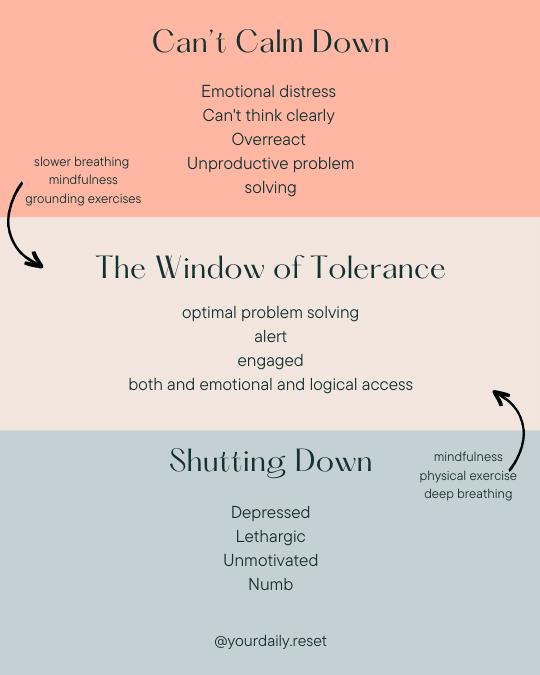Have you ever felt like you just can’t take it anymore? That you’ve reached your limit, that you’re out of control and anything more will push you over the edge? If so, you’re not alone. This is a frequent reality for many women with autoimmune conditions and burnout.
Meet Your Window of Tolerance
The Window of Tolerance is basically the amount of stress that your body can handle before you start to experience negative symptoms. Once your body crosses out of your tolerance “window,” you begin to experience things like anxiety, depression, lethargy, fatigue, brain fog, and even immune system suppression.
But what is this Window of Tolerance, and how can we stay within it? This post will explore what this is and strategies for staying within it.

The Window of Tolerance was developed by Dan Siegel, a Clinical Professor of Psychiatry. The Window of Tolerance describes the best state of ‘arousal’ or stimulation in which we are able to function and thrive in everyday life. When we exist within this window, we are able to learn effectively, play, and relate well to ourselves and others.
Each person has their own window of tolerance. There isn’t a single measurement here. A window of tolerance is based on how much stress your nervous system is already holding and if you’re able to actively and healthily discharge your energy.
A larger window of tolerance means you can handle stressful situations in stride and are able to adequately navigate your emotions and continue to think and act in healthy ways. A larger window of tolerance is equated with resilience.

The States of Window of Tolerance
We can move up into hyper-arousal, which is where we’re excited and aroused, which is a positive feeling, but it can also happen when we’re pushing ourselves too hard to accomplish more and can experience anxiety, which is negative. We can also be “down” in hypo-arousal, where we feel numb, dissociated, and depressed.
Your goal isn’t to never feel excited or sad; that’s what makes you human. Your goal is to be able to move in and out of the windows with ease and grace. It should look more like a gentle wave moving through your window of tolerance rather than sharp peaks and valleys of dysregulation.
This window is the range of emotions and experiences that are just bearable enough to keep you from feeling overwhelmed or stressed. It’s what allows us to feel happy, motivated, and productive most of the time. When we stray too far outside of this range, our mood dips, and we become less effective. Staying within the window of tolerance can help you stay focused, positive, and productive during challenging times.
Practicing tiny tools for getting back into your Window of Tolerance is key for overall health—like you learn here at Your Daily™!
Tools for Maintaining a Healthy Window of Tolerance:
Keep in mind that what regulates us when we’re “up” does not work when we’re “down.” By knowing which state you’re in, you can better understand which tools to use to support yourself.

When you’re up in hyper-arousal:
- The Basic Movement
- Ear rub
- Elongated breath (2x longer exhale than inhale)
- Engage your five senses
- Challenging your thoughts
- Intense exercise
- Muscle relaxation
- Spending time in nature
- Rage journaling

When you’re down in hypo-arousal:
- Fire breath (closed mouth, quick, intense breaths through the nose)
- Cupping the hands and patting the limbs in small slaps or claps
- Tapping
- Swinging arms and legs gently
- Heel drops (stand on tip-toes, drop heels to the ground)
- Walking outside
- Connecting to someone who feels safe
- Journaling

When you’re regulated:
- All of the above
- Self-care
- Boundary setting
- Meditating
- Journaling
If you’re interested in learning about these tools and seeing them in action, join the Your Daily™ Reset Program, where we help you create tiny tools to heal burnout and autoimmune conditions.
In order to thrive in life, it’s important that we learn how to stay in the Window of Tolerance as much as possible. Doing so can reduce our stress levels and improve our overall well-being.
The tips and techniques we’ve shared should help you start your journey towards a more peaceful and contented life. What strategies have you found helpful for staying in the Window of Tolerance?
If you’re interested in learning about these tools and seeing them in action, join the Your Daily™ Reset Program, where we help you create tiny tools to heal burnout and autoimmune conditions.





